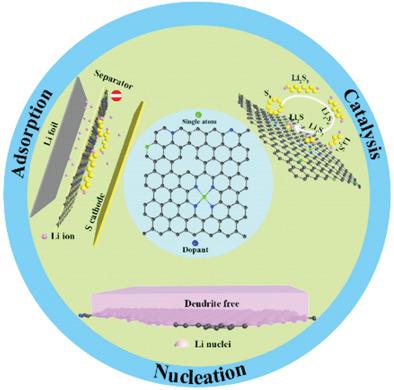当前位置:
X-MOL 学术
›
Small Methods
›
论文详情
Our official English website, www.x-mol.net, welcomes your
feedback! (Note: you will need to create a separate account there.)
Design Principles of Single Atoms on Carbons for Lithium–Sulfur Batteries
Small Methods ( IF 10.7 ) Pub Date : 2020-06-17 , DOI: 10.1002/smtd.202000315 Lingzhe Fang 1 , Zhange Feng 2 , Lei Cheng 3 , Randall E. Winans 4 , Tao Li 1, 4
Small Methods ( IF 10.7 ) Pub Date : 2020-06-17 , DOI: 10.1002/smtd.202000315 Lingzhe Fang 1 , Zhange Feng 2 , Lei Cheng 3 , Randall E. Winans 4 , Tao Li 1, 4
Affiliation

|
The study of lithium–sulfur (Li‐S) batteries has generated various rationally designed cathodes and modified separators. However, the shuttle of soluble lithium polysulfides (LiPSs) and the sluggish kinetics of transformation of LiPSs to Li2S2/Li2S still hinder the achievement of long‐life cycling and high‐rate of Li‐S batteries. Even though several kinds of nanocatalysts have been studied, the catalytic effects for Li‐S batteries are not ideal. Single atoms (SAs) with high surface free energy are found to serve as both anchoring and electrocatalytic centers for LiPSs. Atomically dispersed metal catalysts on carbon provide conductive and flexible hosts for dielectric sulfur. Moreover, SAs as the uniform lithiophilic sites can reduce the nucleation overpotential and ensure uniform plating of Li. In this review, the latest strategies for preparation of SAs supported on carbons are provided for the application of Li‐S batteries, including cathodes, modified separators, and Li metal anodes. In addition, it also discusses how SAs with high catalytic activity can help build better Li‐S batteries and the design principles for SAs. Finally, the future directions of SAs in energy storage applications are proposed.
中文翻译:

锂硫电池碳单原子的设计原理
对锂硫(Li‐S)电池的研究产生了各种合理设计的阴极和改进的隔板。然而,可溶性多硫化锂(LiPSs)的穿梭和LiPS转化为Li 2 S 2 / Li 2的缓慢动力学S仍然阻碍实现长寿命循环和高效率的Li-S电池。尽管已经研究了几种纳米催化剂,但Li-S电池的催化效果并不理想。发现具有高表面自由能的单原子(SA)既可充当LiPS的锚定中心,又可充当电催化中心。碳上原子分散的金属催化剂为介电硫提供了导电和灵活的主体。此外,作为均匀的亲硫性位点的SA可以减少成核的超电势并确保Li的均匀镀覆。在这篇综述中,提供了制备碳载SA的最新策略,以用于Li-S电池的应用,包括阴极,改性隔膜和锂金属阳极。此外,它还讨论了具有高催化活性的SA可以如何帮助构建更好的Li-S电池以及SA的设计原理。最后,提出了SA在储能应用中的未来方向。
更新日期:2020-06-17
中文翻译:

锂硫电池碳单原子的设计原理
对锂硫(Li‐S)电池的研究产生了各种合理设计的阴极和改进的隔板。然而,可溶性多硫化锂(LiPSs)的穿梭和LiPS转化为Li 2 S 2 / Li 2的缓慢动力学S仍然阻碍实现长寿命循环和高效率的Li-S电池。尽管已经研究了几种纳米催化剂,但Li-S电池的催化效果并不理想。发现具有高表面自由能的单原子(SA)既可充当LiPS的锚定中心,又可充当电催化中心。碳上原子分散的金属催化剂为介电硫提供了导电和灵活的主体。此外,作为均匀的亲硫性位点的SA可以减少成核的超电势并确保Li的均匀镀覆。在这篇综述中,提供了制备碳载SA的最新策略,以用于Li-S电池的应用,包括阴极,改性隔膜和锂金属阳极。此外,它还讨论了具有高催化活性的SA可以如何帮助构建更好的Li-S电池以及SA的设计原理。最后,提出了SA在储能应用中的未来方向。











































 京公网安备 11010802027423号
京公网安备 11010802027423号